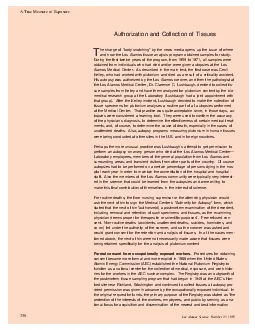

AuthorFormal consent from occupationally exposed workersries for the workers in the AEC nuclear complex The Registry was an outgrowth offord site near Richland Washington and continued to collect t ID: 883857
Download Pdf The PPT/PDF document "A True Measure of Exposure238Los Alamos ..." is the property of its rightful owner. Permission is granted to download and print the materials on this web site for personal, non-commercial use only, and to display it on your personal computer provided you do not modify the materials and that you retain all copyright notices contained in the materials. By downloading content from our website, you accept the terms of this agreement.
1 A True Measure of Exposure238Los Alamos
A True Measure of Exposure238Los Alamos ScienceNumber 23 1995 Author Formal consent from occupationally exposed workers.-ries for the workers in the AEC nuclear complex. The Registry was an outgrowth of-ford site near Richland, Washington and continued to collect tissues at autopsy pro-vided permission was given in advance by the occupationally exposed individual. In-tional focus for acquisition and dissemination of the newest and best information A True Measure of ExposureNumber 23 1995 Los Alamos Science 239relative to the effects of the transuranium elements on people." In 1970, the name-ing at Rocky Flats, were analyzed at the Battelle, PaciÞc Northwest Laboratories,in Richland, Washington. In 1971, the Los Alamos Laboratory was added to thelist of "approved" laboratories. The Battelle and Los Alamos laboratories submit-ted their own research proposals and were funded independently by the AEC forradiochemical analysis of the Registry tissues. In 1978, the Energy Research andDevelopment Agency (ERDA), successor to the AEC, directed that the Los Alam-os tissue analyses laboratory become the lead laboratory for analysis of humantissues for the United States Transuranium Registry (USTR).*Once the Registry was established, physicians in the Industrial Medicine Group atLos Alamos would use the periodic employee medical examinations as a time tointroduce the Registry and its purpose to those Laboratory employees who wereeither known to have, or suspected of having, internal exposure to the transurani-um elements. Individuals willing to release their medical, exposure, and work his-tories to the Registry and to donate tissues following their death were providedadditional detailed information and appropriate consent forms. Those forms weregenerally signed prior to death by the donor, his spouse or nearest next of kin,and a non-related witness. The forms were kept on Þle and had to be renewedevery Þve years to be valid. Also
2 the next of kin could withdraw the cons
the next of kin could withdraw the consent fortissue donation at the time of death if they desired to do so. Potential donors were provided with identiÞcation cards to carry on their personthat notiÞed the attending physician or hospital staff at the time of death of the in-dividual's desire to donate tissues to the U.S. Transuranium Registry. The cardgave a telephone number to be called if death was imminent or had occurred.Once the Registry was notiÞed, they alerted our tissue analysis laboratory, and wesent instructions and shipping containers to the hospital where the autopsy was totake place. Following the autopsy, tissue specimens were individually packagedin plastic bags, frozen, packed in Dry Ice, and shipped to Los Alamos by overnightdelivery.In recent years, the Registry instituted a whole-body donation program in which allinternal organs were removed, packaged as described above, and sent directly toLos Alamos, and the cadaver was shipped to Richland for complete dissection.The skin, muscle, and bones were then shipped to Los Alamos for analyses. Be-cause identiÞcation cards in wallets were sometimes overlooked, whole-bodydonors had the additional option of carrying Medic Alert bracelets or medallions sothat there would be no delay in notifying the Registry of their death. The fact thatthe Registry often knew of an individual's death within a matter of minutes follow-ing the event, or sometimes prior to death, has led some people to conclude thatthe Registry was in collusion with the pathologists or contractors for the DOE toobtain tissue specimens. Thus, the charge of "body snatching.Ó n*In 1978, the Energy Research and Development Agency funded the establishment of theUnited States Uranium Registry (USUR). In 1992, the USTR and USUR were combined toform the United States Transuranium and Uranium Registries (USTUR). An excellent sum-mary of the history of the USTUR is given by R. L. Kathren et al in reference 12